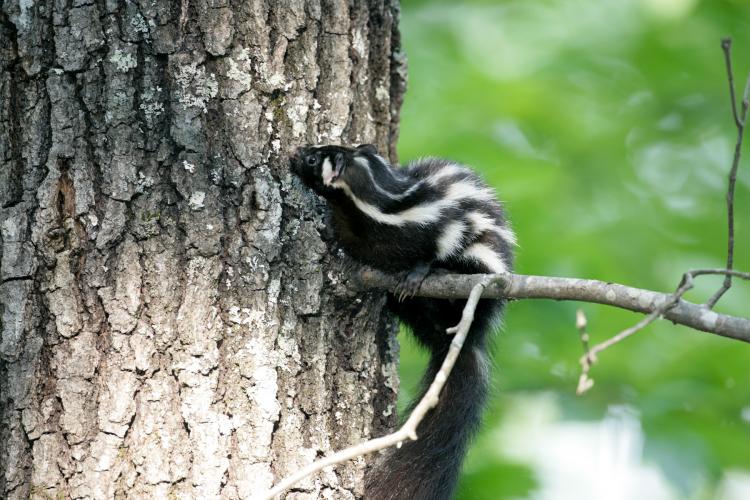
By Alie Mayes, Community Science Specialist
What’s black and white, and does stinky handstands when frightened? Why, the eastern spotted skunk (Spilogale putorius), of course!
It’s not surprising if you’re not familiar with the eastern spotted skunk – or spotted skunk — as the rare mammal has not been reported in the state since 2017. In fact, there have only been four confirmed sightings of the spotted skunk in Nebraska since 2009, all in the northern part of the state. Yearly, there are fewer sightings of the spotted skunk than there are reports of the endangered whooping crane.
The spotted skunk is also known as a civet or polecat. They are small, about the size of a large fox squirrel, and similarly, the spotted skunk also climbs trees, has a long sleek body and a bushy tail. They are primarily black with broken white stripes and spots. Spotted skunks are nocturnal, meaning they are active at night. Their shy and secretive nature makes sightings all the more difficult.
Historically, the spotted skunk thrived in Nebraska. Family farms gave these nocturnal creatures a relatively safe environment, where they ate the small animals (insects, mice, etc.) that were attracted to croplands. Additionally, their own predators, such as coyotes, bobcats, hawks and owls, were reduced due to human activity. However, since the 1940s, spotted skunk populations in Nebraska have decreased significantly. This decline may be due to changes in farming practices, as operations moved away from small family farms to fewer and more expansive ones.
The eastern spotted skunk is a Tier-1 species in Nebraska, meaning it is considered imperiled in the state. On a federal level, the spotted skunk is being reviewed by the U.S. Fish and Wildlife Service for possible inclusion on the threatened and endangered species list. This requires the Nebraska Game and Parks Commission to learn more about the abundance of spotted skunks in the state. Game and Parks and the University of Nebraska Omaha are working to close to gather more data, and they need your help. So, how can you get involved with the search for spotted skunks in Nebraska?
Report sightings
If you see or find a spotted skunk in Nebraska, please report the location, preferably with photos, to ngpc.spottedskunk@nebraska.gov.
Host a camera trap
Nebraska Game and Parks and UNO have set up a network of camera traps (trail cameras) to hopefully capture confirmed sightings of spotted skunks. If you are a landowner, consider hosting a camera trap to help us collect more data. Learn how to get involved at OutdoorNebraska.gov. The springtime is a great time to get involved in camera trapping efforts because eastern spotted skunks are more active during their breeding season, which happens March through early May.
Participate in Nebraska Wildlife Watch
Help tag camera trap images online at zooniverse.org. Photos from the camera trap network mentioned previously are uploaded to the project “Nebraska Wildlife Watch”. There, community scientists, everyday people like you who have a desire to participate in scientific research, help label what animals are found in each picture.

For updates about spotted skunk research in Nebraska, follow @NESpottedSkunks on Facebook.
